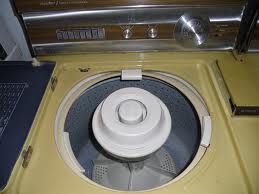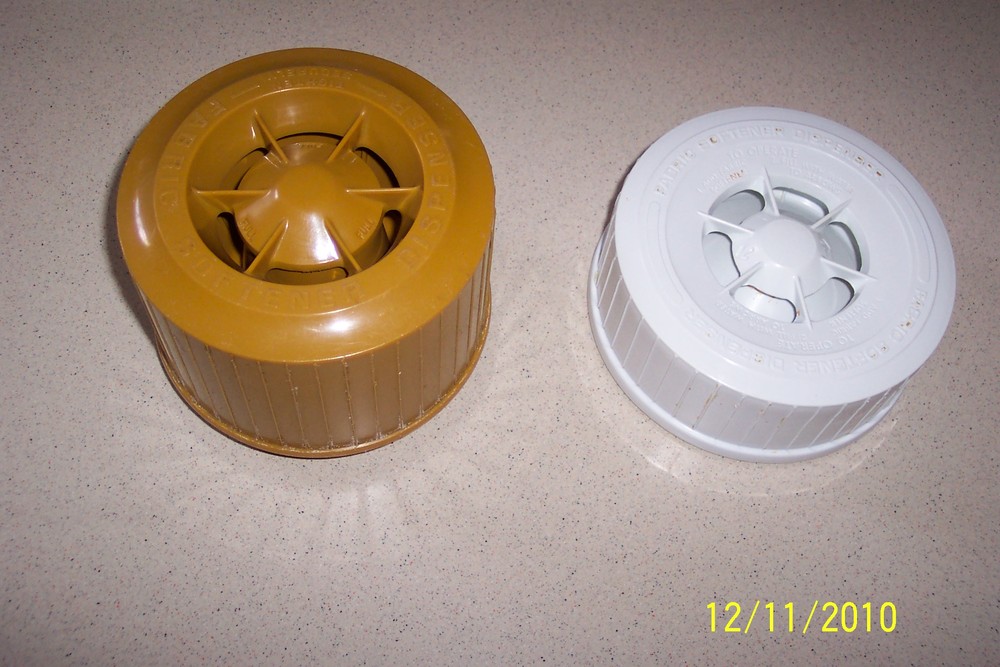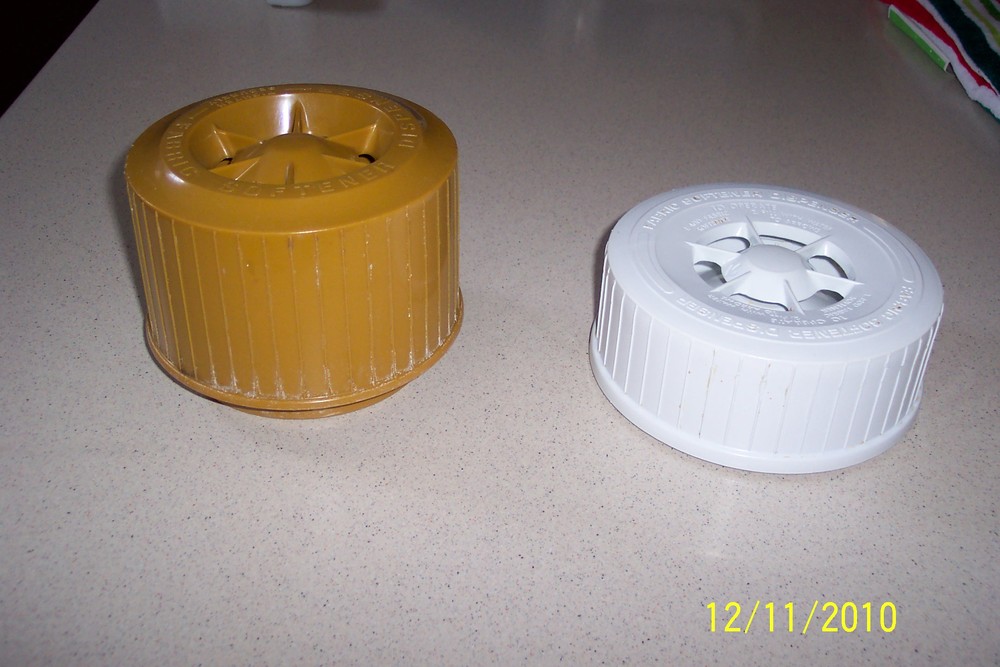|
Thread Number: 31894
Top Loading Fabric Dispensers..... |
[Down to Last] |
| Post# 480896 12/11/2010 at 06:47 (4,878 days old) by keymatic (London / UK) | ||

Dear All,
I was wondering if any of you can briefly explain to me how vintage fabric dispensers work. I was recently watching a General Electric 1968/9 filter flo & Lady kenmore whereby the dispenser sat on top of the agi, sometimes above the filter pan. I noticed that the conditioner was loaded at the start of the wash, then upon the spin cycle the liquid disappeared, but i would like to know how these units work..can anyone help..? Cheers Keith 
| ||

|
Post# 480897 , Reply# 1 12/11/2010 at 07:07 (4,878 days old) by polkanut  (Wausau, WI ) (Wausau, WI ) |
||

I'll give it a shot. During the first spin the diluted softener is thrown out of the dispenser cup and held against the outer wall of the dispenser by centrifugal force. When the spin stops the liquid drains out through holes in the bottom of the dispenser and into the rinse water. It's really quite simple.
If someone can explain it better, go ahaead, I won't be offended in the least. | ||
Post# 480902 , Reply# 3 12/11/2010 at 07:28 (4,878 days old) by Tomturbomatic  (Beltsville, MD) (Beltsville, MD) |
||
|
Sorry, I started around 7, but type slower. I was the reason for the sign that read SLOW child playing | ||
Post# 480922 , Reply# 4 12/11/2010 at 08:57 (4,878 days old) by akronman  (Akron/Cleveland Ohio) (Akron/Cleveland Ohio) |
||
Fabric Softener dispenser | ||
Post# 480941 , Reply# 5 12/11/2010 at 10:11 (4,878 days old) by Kenmoreguy64  (Charlotte, NC) (Charlotte, NC) |
||

A few added notes:
Our 1974 and 1983 Kenmores came with a dispenser of this nature. The 74's was better in that it was truly a two piece unit that purposely came apart and allowed for easy clean-up. The instructions with it said "Fill with the proper amount of softener, then fill the rest with clear water to dilute mixture" or something like that. This was intended to help reduce the build-up of softener sludge, which can be particularly difficult to remove once it begins to accumulate. The inner bowl of the 74's dispenser has four little little mixing blades on the outside edges, that during agitation help stir the blend of softener and water. I used to clean ours all the time until one day when I dropped the inner portion and broke off a piece of the lower-most rim. This allowed softener to fling out during spin and the dispenser became useless. Our '83 dispenser is built to the same apparent design, however it doesn't come apart for cleaning, which in my view is not one of Kenmore's brighter ideas. To really clean it well you need a wire brush, which is stupid, or the dishwasher, and that doesn't even always work. As to using the dispensers on delicate, I don't recall having any issues - the spin speed is still sufficient (yes even in a WP/Kenmore belt-drive!). I have a couple of these - I think I'll take some pics to share. BRB! Gordon | ||
Post# 480942 , Reply# 6 12/11/2010 at 10:28 (4,878 days old) by Kenmoreguy64  (Charlotte, NC) (Charlotte, NC) |
||
Here are some just-taken pics:
Outer shots of both Kenmore dispensers. The gold one was used from 1973 or so until the late 70s. A white version of the same dispenser was available until 1986 in new machines.
The dispenser on the right was developed for Dual-Action agitators, and was used in great quantity until the end of belt-drive production. This is dispenser which does not easily come apart. 
| ||
Post# 480943 , Reply# 7 12/11/2010 at 10:31 (4,878 days old) by Kenmoreguy64  (Charlotte, NC) (Charlotte, NC) |
||

Height difference.....
The dispenser on the left was available on various models equipped with Straight-Vane, Super Roto-Swirl, Penta-Vane, Penta-Swirl, and Compact straight-vane agitators. Oddly, most often when acquiring a machine second-hand, they seldom seem to come with their original dispensers. 
| ||
Post# 480945 , Reply# 8 12/11/2010 at 10:31 (4,878 days old) by Kenmoreguy64  (Charlotte, NC) (Charlotte, NC) |
||
 | ||
Post# 480946 , Reply# 9 12/11/2010 at 10:34 (4,878 days old) by Kenmoreguy64  (Charlotte, NC) (Charlotte, NC) |
||
 | ||
Post# 480947 , Reply# 10 12/11/2010 at 10:34 (4,878 days old) by Kenmoreguy64  (Charlotte, NC) (Charlotte, NC) |
||
 | ||
Post# 480948 , Reply# 11 12/11/2010 at 10:48 (4,878 days old) by Kenmoreguy64  (Charlotte, NC) (Charlotte, NC) |
||

I have always thought that these were pretty simple yet effective. The electrically operated reservoir dispensers tend to "gunk-up" and clog.
I've always wondered something about belt-drives and softener that is added at the very beginning of rinse. The softener would tend to flow down into the manifold trap along with the first cup or two of rinse water. On models where the drain hose begins immediately from the pump (in other words models without the remote plumbed self-cleaning lint filters), would much of the softener get flushed down the drain at agitation start since all BDs drain a bit of water before the pump is shifted? This would be water in the manifold and pump. Models with the later high output two and three port pumps dump even more water, so to counter this I don't use the dispensers. Maybe one day I'll have to do a test to find out.... Gordon | ||
Post# 480966 , Reply# 13 12/11/2010 at 12:42 (4,878 days old) by Tomturbomatic  (Beltsville, MD) (Beltsville, MD) |
||
|
This post has been removed by the member who posted it. | ||
| Post# 481105 , Reply# 14 12/12/2010 at 04:21 (4,877 days old) by keymatic (London / UK) | ||

Hi Guys..
Thanks so much for all the information supplied, it has cleared the cloudy principal that i once had on how these things work. In the UK we didn't have anything like this, the closest we got was just adding the fabric conditioner to the filter clean pan during the rinse cycle. By the time that most people had started using fabric conditioner our machines had merged from top loaders to front loaders to where the liquid was put in the soap dispenser draw with the powder. Cheers Keith | ||
Post# 481135 , Reply# 15 12/12/2010 at 08:37 (4,877 days old) by combo52  (50 Year Repair Tech Beltsville,Md) (50 Year Repair Tech Beltsville,Md) |
||
CLEANING FABRIC SOFTENER DISPENSERS
NEVER NEVER wash in the dishwasher if you are washing dishes at the same time and you probably shouldn't do it at all. I put a WP dispenser in our 1966 KM D&M machine when I was a kid and it left such a bad film on every item in the load that four more washings would not remove. Mom and I finally had to wash all the dishes by hand with a lot of scrubbing.
| ||

 Comes to the Rescue!
Comes to the Rescue!